Every April, many expats who live in Pattaya choose to escape the mayhem that has replaced the traditionally serene Songkran Festival. This year, 15 expats escaped to Java, one of the main islands of Indonesia, on a fascinating six-day trip organized by a PCEC Club member. On June 26, three of them – Pat Koester, Gillian Kiltrick and Anne Smith – were guest speakers at the PCEC meeting. They took the audience on a photo journey to some of the many places they visited, focusing on their impressions and experiences.
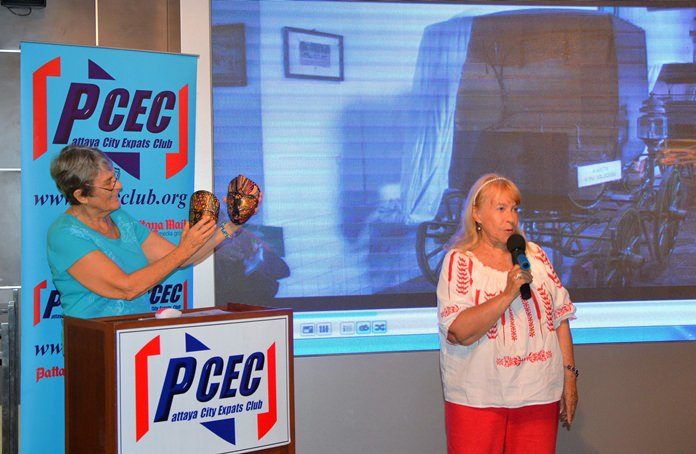
In Java, the group visited the towns of Solo and Yogyakarta; two ancient Hindu temples and an ancient Buddhist temple; two royal palaces; a water castle; a batik museum; a silver workshop; a master steel craftsman who makes the Kris, the ceremonial magic dagger that’s famous for its distinctive wavy blade and elaborately carved sheath; and a home industry that produces “the most expensive coffee in the world.”
All three speakers said one of their deepest impressions was the graciousness of the Indonesian people. Wherever the group went, they were virtually the only foreigners, and the local people were always smiling and eager to have their photos taken with them.
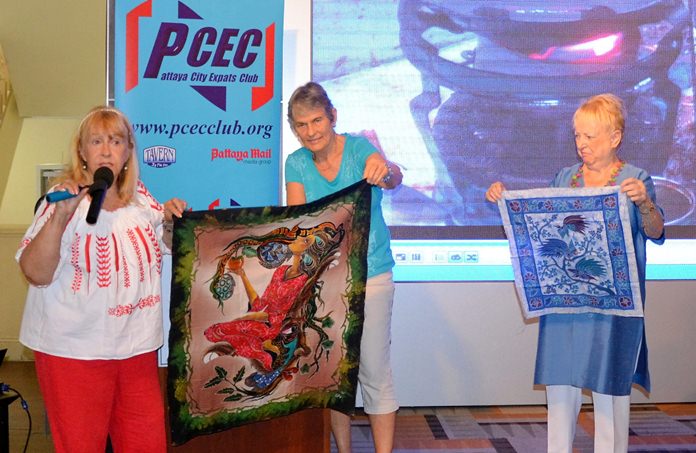
Pat said she was surprised the first evening in Solo, which is said to be one of the least Westernized cities in Java, when several members of the group went exploring on foot, and ran into a street food vendor with the word “Amerika” painted across his stall. The next day, the group enjoyed exploring the city via rickshaws, or bechak as they are called there.
On the lush green mountains about an hour outside of Solo, the group visited two ancient Hindu temples, Candi Sukuh and Candi Cetho. Pat explained that before Indonesia became a Muslim country, Hinduism and Buddhism were the predominant religions there. Candi Sukuh, built during the 15th century, has a large, truncated pyramid of rough-hewn stone that resembles Mayan architecture in South America; it’s a mystery how such similar architecture ended up on opposite sides of the world. Candi Cetho, built around the year 1350, resembles Hindu temples found in Bali, the only place in Indonesia where Hinduism still predominates. Everyone who visits Candi Cetho is required to wrap a black-and-white checkered cloth around their waist. Pat noted the irony that in Bali, the same type of cloth is used to wrap around the private parts of nude statues, whereas here it’s the people who have to cover themselves while the many graphically sexual statues and stone carvings remain exposed.
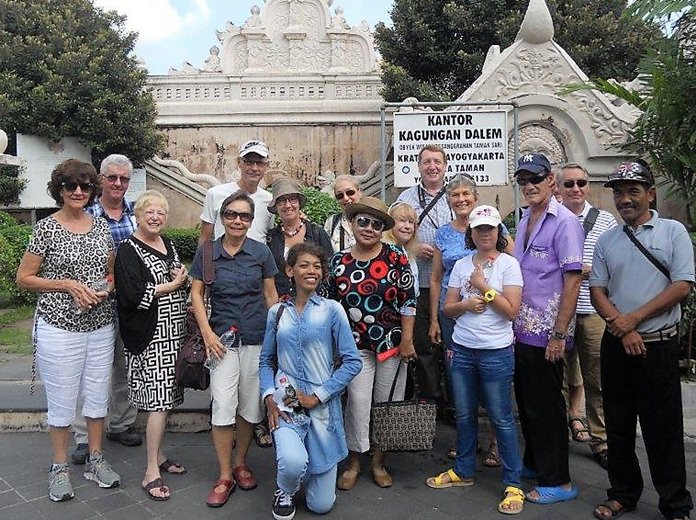
Pat said the highlight of the tour for her and many others in the group was the visit to Borobudur, a huge Mahayana Buddhist Temple near Yogyakarta that has been designated a UNESCO Heritage site. Borobudur was built around the beginning of the 9th century – 300 years before Angkor Wat in Cambodia. For centuries it was buried beneath layers of volcanic ash from the nearby Mount Merapi volcano. Then in 1814, Sir Thomas Raffles, the British ruler of Java, appointed a team to investigate a hill, which, according to many local inhabitants, was the site of an ancient monument. It took 20 years to clear the entire area of the temple.
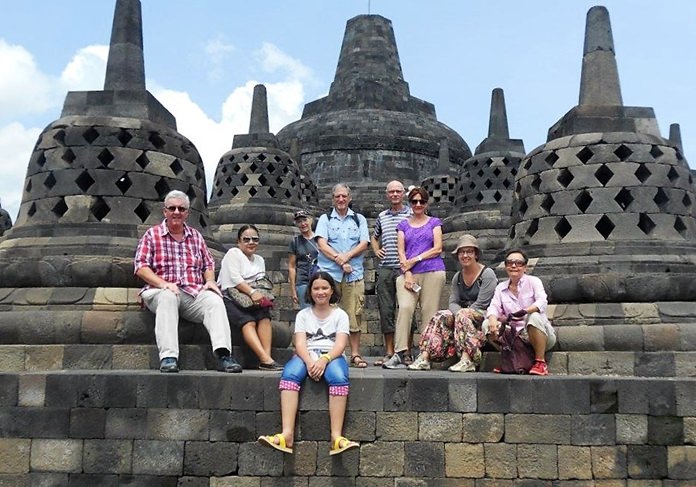
Borobudur is the largest Buddhist monument in the world. Most of the PCEC group members managed to climb up the four square levels and three circular levels of Borobudur. The square levels feature almost 3 kilometers of decorative panels and carved stone reliefs depicting Sanskrit manuscripts, as well as numerous niches containing statues of Buddha. The three upper circular levels represent the abode of the gods, rising above the world. They contain 72 perforated stupas, some containing a Buddha image. There are a total of 504 Buddha images throughout the monument.
Back in Yogyakarta, the group visited the Sultan’s Palace and its Kareta museum, which displayed beautiful, ornate horse-drawn carriages once used by the sultans of Yogyakarta. Gillian Kiltrick said the carriages reminded her of her childhood days in Britain, when carriages were status symbols. Gillian also talked about her surprise at the wide variety of batik cloths on display at the Danar Hadi Batik Museum in Solo. Both she and Anne Smith displayed the beautiful pieces of batik that they purchased. Gillian also showed the audience the beautiful filigree ring that she purchased at the silver workshop.
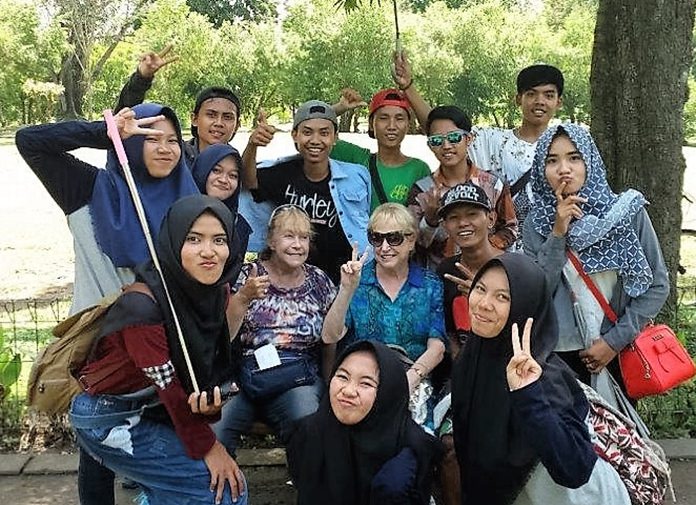
Anne shared her experience at the Mataram Kopi Luwak Coffee home industry, which produces “the most expensive coffee in the world.” The process involves an animal called the civet cat eating the coffee beans off the trees, and then the feces being collected and the beans recovered and processed into coffee. Apparently, the digestive process of the civet cat produces some kind of unique fermentation that gives the civet coffee its special flavor. Anne explained that only 500 to 1,000 pounds, or 250 to 500 kilograms, of the coffee are produced per year. One cup of the coffee costs between $35 and $100.
In Yogyakarta, the group enjoyed staying at the elegant Colonial-era Phoenix Hotel, built in 1918. In addition to the beautiful architecture and decor of the hotel, Anne, a classic car buff, was also intrigued by the assortment of vehicles outside the hotel’s front door, including a 1962 Mercedes Benz, two pink taxis, and a gold rickshaw.
Pat announced that for Songkran 2017, a trip to Vietnam is being planned. She advised everyone to mark their calendar and start saving their pennies!
After the presentation, MC Roy Albiston brought everyone up to date on upcoming events and called on Ira Wettenstein to conduct the Open Forum, where questions are asked and answered about Expat living in Thailand, especially Pattaya. For more information on the PCEC’s many activities, visit their website at www.pcecclub.org.




